The Halifax Building Society
Headquarters of the eponymous financial institute
“The Halifax” was formed out of the Loyal Georgian Society, a friendly society which did some lending. Its decision to withdraw from lending led directly to the formation of the Building Society. The Halifax Permanent Building and Investment Society was proposed by the great and the good of the town at a meeting in December 1852. Its rules were ratified in February 1853 and it was registered under the 1836 Building Societies Act, with the “Investment” omitted from its title. Jonas Taylor, a 24-year-old lawyer's clerk, was appointed Secretary and he was supported as president by John Fisher, manager of the Halifax Joint Stock Banking Company. Jonas Taylor was to serve as Secretary of the Halifax for almost fifty years and he was responsible for the Society's strategy of branch expansion from its beginning. Three branches were opened in its first year and by 1862 there were a total of 12 branches, all local. The first move out of Halifax came in 1862 with the formation of a branch in Huddersfield, replete with its own chairman and Directors.
One of the features of the Halifax was its willingness to finance the philanthropic housing development by prominent local businessmen. Edward Akroyd, a local mill owner, financed the building of working-class houses “built cheaply, perhaps without taste” through his Goahead Building Club. His subsequent plan to build a “superior class of dwellings” involved the formation of a Building Association and it was this development of the Akroydon model housing scheme in the 1860s that was financed by the Halifax. There followed a more substantial scheme with John Crossley, a carpet manufacturer, creating The West Hill Park Model Dwellings.
The 1903 history dutifully recorded the branch expansion in the late decades of the nineteenth century. By 1871 another ten local offices had been opened, supported by the construction of a new head office in 1873. Another 22 were opened in the next decade including the important cities of Bradford and Leeds; the Halifax had developed a significant regional presence. By 1902 there were 11 principal branches, all in Yorkshire cities, with a further 49 smaller branches.
One of the early decisions was to concentrate on owner occupiers, particularly ofcheaper properties. In 1904/5 the Halifax claimed to have opened more new accounts than any incorporated building society in the UK; in 1908 it had the largest advances and by 1913 it was the largest building society by size of assets. Despite its size, by the end of WWI the Halifax was still largely based in Yorkshire and Lancashire and the next stage was to take the Society national. The first branch in the south was opened at Shaftesbury in 1919; the all-important London office followed in 1924. Between 1918 and 1928 around 100 new branches and agencies were opened, doubling the Halifax's coverage; that decade finished with new offices in Glasgow and Edinburgh.
By 1928 Halifax was in the unique position of having the two largest building societies in the country and they decided to merge. The Halifax Equitable Building Society had been formed in 1871 and it too grew rapidly. By 1911 it claimed to be the 11th largest; third by 1921 and second by 1924. At the time of the merger the Halifax Permanent had assets of £33m and the Equitable £14m. One of the features of the Equitable was that it had formed its own bank in 1900 - the Halifax Equitable Bank. Although independent from the building society, only society members could buy shares.
The new head office, visible from Beacon Hill, was built at Trinity Road, Halifax, in 1973. The distinctive diamond-shaped building was used on marketing material during the 1980s and 1990s. Underneath the building is a specially constructed deedstore which was used to store property deeds. Its importance has diminished in recent years because property data is now kept on a central database kept by HM Land Registry.
In 1995, the Halifax announced it was to merge with the Leeds Permanent Building Society and convert to a plc. The Halifax floated on the London Stock Exchange on 2 June 1997. Over 7.5 million customers of the Society became shareholders of the new bank, the largest extension of shareholders in UK history. In 2001, a wave of consolidation in the UK banking market led Halifax to agree a £10.8 billion merger with the Bank of Scotland. The new group was named Halifax Bank of Scotland (HBOS) with headquarters in Edinburgh, and retained both Halifax and the Bank of Scotland as brand names.
In 2006, the HBOS Group Reorganisation Act 2006 was passed. The aim of the Act was to simplify the corporate structure of HBOS. The Act was fully implemented on 17 September 2007 and the assets and liabilities of Halifax plc transferred to Bank of Scotland plc. The Halifax brand name was to be retained as a trading name, but it no longer exists as a legal entity.
HBOS was acquired by the Lloyds Banking Group in January 2009 amid falling share price and speculation as to its future. Bank of Scotland plc (including its brands such as Halifax) became a wholly owned subsidiary of the group.
The bank maintains a ‘history site at
\https://www.lloydsbankinggroup.com/who-we-are/our-heritage/halifax-bank.html
Related pages...
Calderdale Royal Hospital
more The main Hospital for the the town
Shaw Lodge Mills
more A brief history of this icon of the textile industry in the Halifax area

The Shay Stadium
more The home of professional sport in the town

Eureka! The National Children's Museum
more A popular children's museum
_1.jpg)
Wainhouse Tower
more A victorian "Folly"
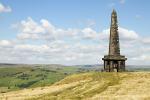
Stoodley Pike
more A war memorial in the Todmorden area
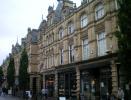
The Halifax Borough market
more The victorian covered market in the town centre
_1.jpg)
Square Church Spire
more The spire is all that remains of this church
_1.jpg)
The Piece Hall
more Halifax's jewel in the crown
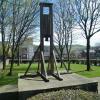
The Halifax Gibbet
more A forerunner of the Guillotine
Halifax Town Hall
more Seat of Local Governance

Halifax Minster
more The centre of worship in Town

Dean Clough
more An industrial powerhouse of the past
_1.jpg)
All Souls Church
more The church of a former model village
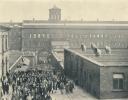
Black Dyke Mills
more An icon on the outskirts of Halifax
back to page above this...
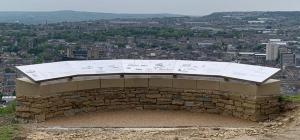
The Centenary Viewing Platform at Beacon Hill
back To celebrate 100 years of service to the town of Halifax we have commissioned viewing platform on Beacon Hill overlooking the town. Situated on the Magna Via, an old packhorse route, the walk to the top is worth it.